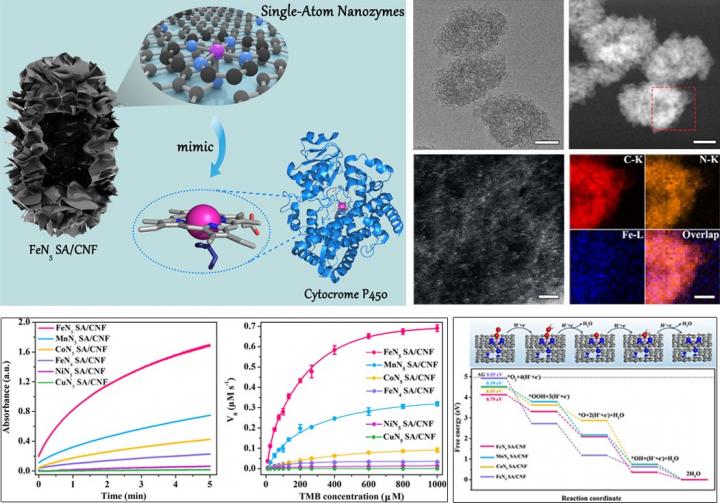
Credit: DONG Shaojun
Nanozymes – catalytic nanomaterials with enzyme-like characteristics – offer the advantage of low cost, high stability, tunable catalytic activity and ease of mass production. For these reasons, they have been widely applied in biosensing, therapeutics and environmental protection.
However, the low density of active sites in nanozymes is related to much lower catalytic activity than with natural enzymes. In addition, their inhomogeneous elemental composition and facet structure-derived intricate catalytic mechanisms seriously restrict the extensive application of conventional nanozymes.
A research team led by Prof. DONG Shaojun from the Changchun Institute of Applied Chemistry (CIAC) of the Chinese Academy of Sciences discovered a new class of single-atom nanozymes, which integrates state-of-the-art single-atom technology with intrinsic enzyme-like active sites.
The researchers synthesized single-atom nanozymes with carbon nanoframe-confined axial N-coordinated FeN5 centers (FeN5 SA/CNF). Theoretical calculations and experimental studies indicated that the highest oxidase-like activity of FeN5 SA/CNF was derived from the enzyme-like active sites and catalytic mechanisms.
The atomically dispersed metal centers maximized the atomic utilization efficiency and density of the active sites. The well-defined coordination structure provided a clear experimental model for mechanism investigation.
The current results suggest that the single-atom nanozymes overcame the critical drawbacks of conventional nanozymes. In addition, mimicking the active sites of natural enzymes appears to be an efficient method for the synthesis of single-atom nanozymes with high activity and clear mechanism.
Furthermore, the catalytic property and the mechanism of single-atom nanozymes depend mainly upon the steric configuration of active centers, rather than the size, structure or facet of the supports. Thus, through altering the supported nanomaterials, certain types of active sites can be extended to general applications with definite enzyme-like mechanisms.
The study, published in Science Advances, shows that defined single-atom nanozymes provide a new perspective on the catalytic mechanism and rational design of nanozymes. They also show great potential for becoming the next generation of nanozymes.
###
Media Contact
DONG Shaojun
[email protected]
Related Journal Article
http://dx.




